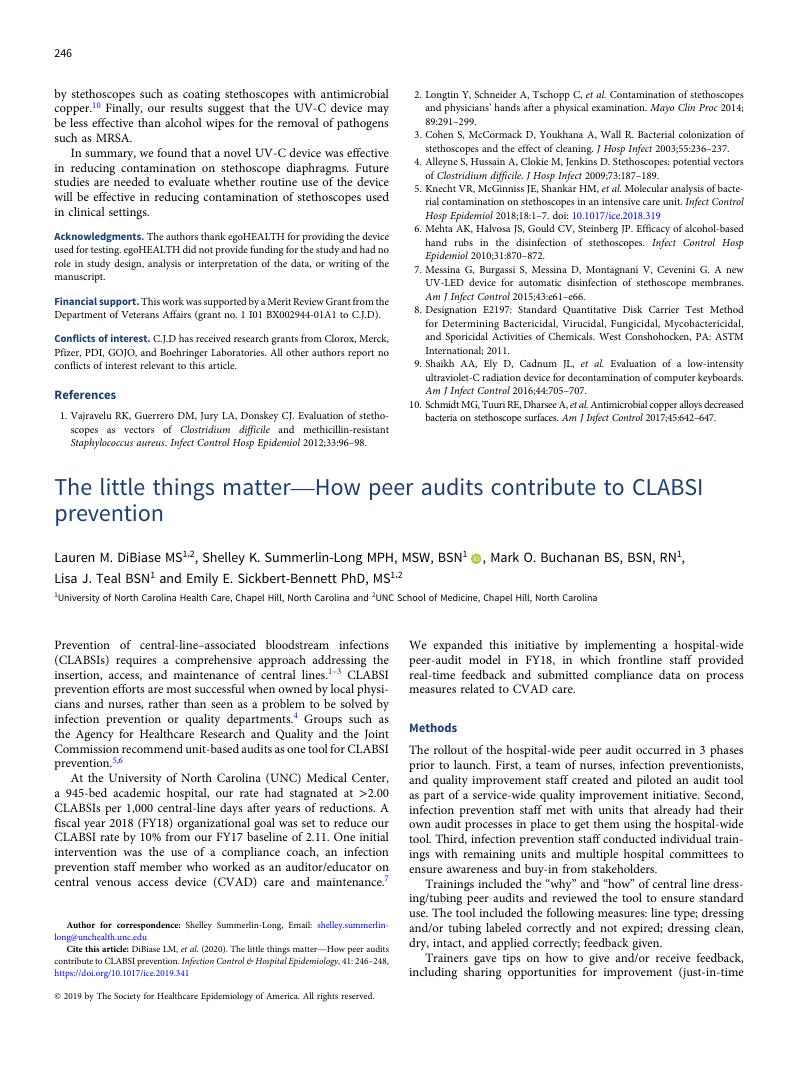No CrossRef data available.
Article contents
The little things matter—How peer audits contribute to CLABSI prevention
Published online by Cambridge University Press: 16 December 2019
Abstract
An abstract is not available for this content so a preview has been provided. Please use the Get access link above for information on how to access this content.

- Type
- Research Brief
- Information
- Copyright
- © 2019 by The Society for Healthcare Epidemiology of America. All rights reserved.
References
Lee, KH, Cho, NH, Jeong, SJ, Kim, MN, Han, SH, Song, YG.Effect of central-line bundle compliance on central-line–associated bloodstream infections. Yonsei Med J 2018;59:376–382.CrossRefGoogle ScholarPubMed
Guerin, K, Wagner, J, Rains, K, Bessesen, M.Reduction in central-line–associated bloodstream infections by implementation of a postinsertion care bundle. Am J Infect Control 2010;38: 430–433.CrossRefGoogle ScholarPubMed
Ista, E, van der Hoven, B, Kornelisse, RF, et al.Effectiveness of insertion and maintenance bundles to prevent central-line–associated bloodstream infections in critically ill patients of all ages: a systematic review and meta-analysis. Lancet Infect Dis 2016;16:724–734.CrossRefGoogle ScholarPubMed
Pham, JC, Goeschel, CA, Berenholtz, SM, et al.CLABSI conversations: lessons from peer-to-peer assessments to reduce central-line–associated bloodstream infections. Qual Manag Health Care 2016;25:67–78.10.1097/QMH.0000000000000091CrossRefGoogle ScholarPubMed
Guide: purpose and use of CLABSI tools. Agency for Healthcare Research and Quality website. https://www.ahrq.gov/professionals/education/curriculum-tools/clabsitools/guide.html Accessed June 2, 2019.Google Scholar
CLABSI toolkit and monograph. The Joint Commission website. https://www.jointcommission.org/topics/clabsi_toolkit.aspx. Accessed June 2, 2019.Google Scholar
Buchanan, MO, Summerlin-Long, SK, DiBiase, LM, Sickbert-Bennett, EE, Weber, DJ.The compliance coach: a bedside observer, auditor, and educator as part of an infection prevention department’s team approach for improving central line care and reducing central line-associated bloodstream infection risk. Am J Infect Control 2019;47:109–111.10.1016/j.ajic.2018.06.005CrossRefGoogle ScholarPubMed


